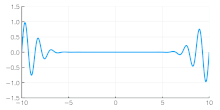
Back حزمة موجية Arabic Dalğa paketi Azerbaijani Paquet d'ona Catalan Vlnový balík Czech Wellenpaket German Paquete de ondas Spanish Lainepakett Estonian Uhin fardel Basque بسته موج Persian Paquet d'onde French

In physics, a wave packet (also known as a wave train or wave group) is a short burst of localized wave action that travels as a unit, outlined by an envelope. A wave packet can be analyzed into, or can be synthesized from, a potentially-infinite set of component sinusoidal waves of different wavenumbers, with phases and amplitudes such that they interfere constructively only over a small region of space, and destructively elsewhere.[1] Any signal of a limited width in time or space requires many frequency components around a center frequency within a bandwidth inversely proportional to that width; even a gaussian function is considered a wave packet because its Fourier transform is a "packet" of waves of frequencies clustered around a central frequency.[2] Each component wave function, and hence the wave packet, are solutions of a wave equation. Depending on the wave equation, the wave packet's profile may remain constant (no dispersion) or it may change (dispersion) while propagating.
- ^ Joy Manners (2000), Quantum Physics: An Introduction, CRC Press, pp. 53–56, ISBN 978-0-7503-0720-8
- ^ Schwartz, Matthew. "Lecture 11: Wavepackets and dispersion" (PDF). scholar.harvard.edu. Archived (PDF) from the original on 2023-03-18. Retrieved 2023-06-22.
© MMXXIII Rich X Search. We shall prevail. All rights reserved. Rich X Search